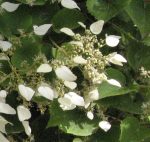 Native to the moist woodlands of Japan, this deciduous woody vine belongs to the hydrangea family, Hydrangeaceae, that also includes mock orange and Deutzia. The vines grow 20-30′ long and climb by means of aerial roots. The reddish brown stems carry heart-shaped, dark green leaves that are toothed, 3-6″ long, and turn yellow in the fall. Flat-topped, lace-cap clusters of flowers appear in early summer. They are 8-10″ across and consist of very small creamy white fertile flowers surrounded by showy sterile florets with a single ovate white petal-like sepal. The vines are slow to establish but are beautiful climbing over, rocks, trees, walls, arbors, and other garden structures. The genus name, Schizophragma, comes from the Greek words σχίζω (schizo) meanng to split and φράγκμα (phragma) meaning a fence and refers to the inner wall of the fruit capsule. The specific epithet, hydrangeoides, refers to the resemblance of the leaves those of hydrangeas.
Native to the moist woodlands of Japan, this deciduous woody vine belongs to the hydrangea family, Hydrangeaceae, that also includes mock orange and Deutzia. The vines grow 20-30′ long and climb by means of aerial roots. The reddish brown stems carry heart-shaped, dark green leaves that are toothed, 3-6″ long, and turn yellow in the fall. Flat-topped, lace-cap clusters of flowers appear in early summer. They are 8-10″ across and consist of very small creamy white fertile flowers surrounded by showy sterile florets with a single ovate white petal-like sepal. The vines are slow to establish but are beautiful climbing over, rocks, trees, walls, arbors, and other garden structures. The genus name, Schizophragma, comes from the Greek words σχίζω (schizo) meanng to split and φράγκμα (phragma) meaning a fence and refers to the inner wall of the fruit capsule. The specific epithet, hydrangeoides, refers to the resemblance of the leaves those of hydrangeas.
Type: Deciduous woody climber
Bloom: Heads of small creamy-white flowers surrounded by sterile florets with showy petal-like white sepals
Size: 20-30′ H x 6-9′ W
Light: Full sun to part shade
Soil: Average, medium moist, well-drained
Hardiness: Zones 5-8
Care: Prune in late winter to early spring
Pests and Diseases: None of significance
Propagation: Softwood cuttings in early to mid-summer, semi-ripe cuttings in late summer
Outstanding Selections:
‘Moonlight (blue green ovate leaves with a silverly overlay and large white flowerheads)
‘Roseum’ (flowerheads with edging of pink sterile florets )
Photo Credit:Wikimedia